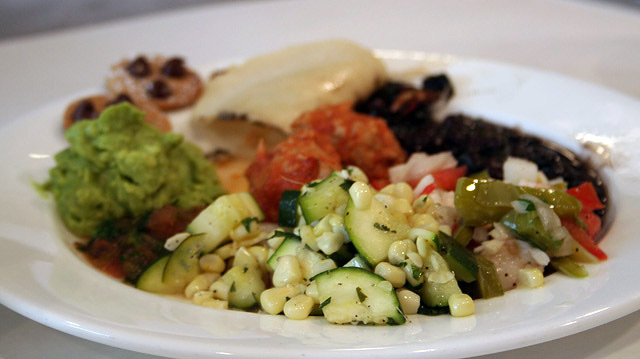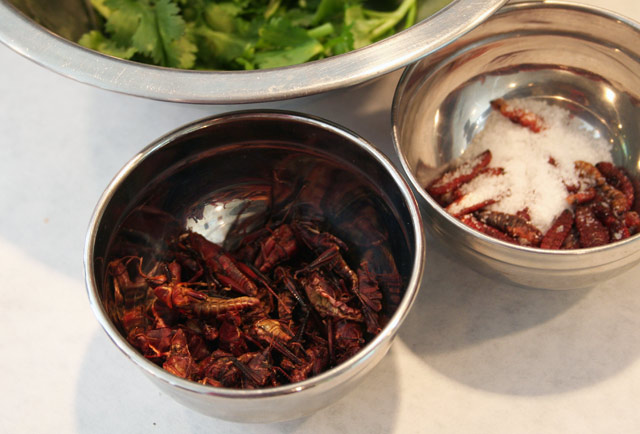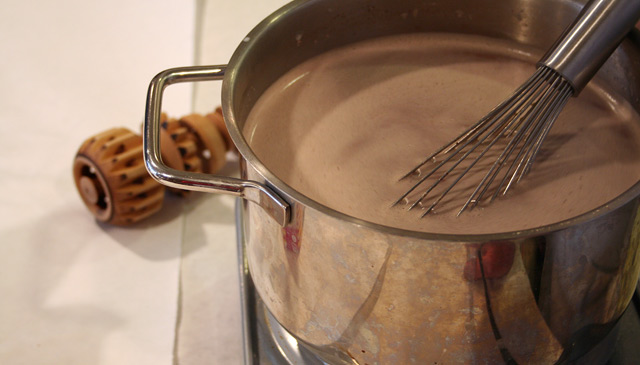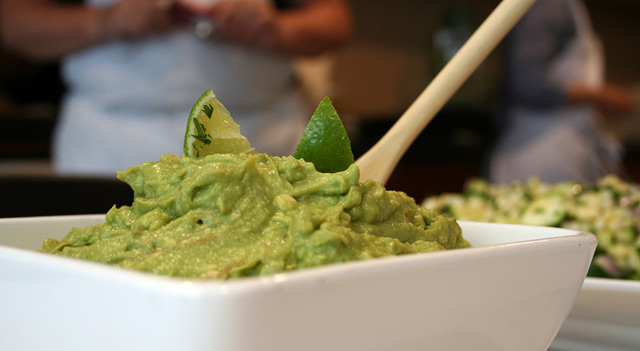
Mexican cooking as we know and love it in the U.S.—moles, carne asada, burritos, cafe con leche, loads of melty cheese—would have been unrecognizable to the Aztecs. They didn’t have cows, pigs, sugar, cheese, butter, cinnamon, or wheat. They did, however, have an abundance that astonished the Europeans who arrived in the 1500s: corn of many colors, beans, chiles, chocolate, cactus, avocados, tomatoes, lake fish and shrimp, fowl of every description, agave nectar, intoxicating pulque, even dog, grasshopper, and worm. Of squash alone there were 760 kinds.
“It was all so wonderful,” said conquistador Bernal Diaz del Castillo in 1521 upon seeing the Aztec capital of Tenochtitlan (present-day downtown Mexico City), “that we do not know how to describe the first glimpse of things never heard of, seen, or dreamed before.”
At a recent series of culinary workshops held in conjunction with the exhibition The Aztec Pantheon and the Art of Empire, which closes this coming Monday, July 5, art historian and chef Maite Gomez-Rejón took us on a culinary journey, first by exploring sculptures in the exhibition—including the amaranth disks and stunningly realistic ears of corn on the Incense Burner with Chicomecoatl, goddess of the all-important fully ripe corn—then through chopping, simmering, and eating in the Villa’s cozy Education Studio.
Maite, who runs ArtBites, has blogged about the wow moments she experienced while studying the exhibition for the course, and our group had our own wow moments as we dared one another to nibble spiced grasshoppers and salted maguey worms (shown below), strove to mold and flip the perfect tortilla, and took turns frothing chocolate with molinillo and whisk, all with Maite’s patient and expert guidance.


In a little more than an hour, we created a meal of varied spice, texture, and color using only Aztec ingredients. (Okay, we cheated a little by sneaking in a few Old World necessities, such as lime from Asia. “I love limes,” admitted Maite, “I put them in everything!”)
2010 is the bicentennial of Mexican independence, but this Aztec feast would be a creative menu for an American Independence celebration this Sunday, too. Four of the recipes with Maite’s notes are listed below; asterisks indicate Old World ingredients. To get a printable version of all the recipes for the feast, including amaranth cookies, black beans, hot chocolate, and corn tortillas, download the full recipe pack as a PDF here.
Ensalada de Maíz con Calabaza | Corn and Zucchini Salad
The life force of the Americas, maize (corn) has been domesticated in Mexico for over 10,000 years. The Aztecs grew over 760 species of squash. The Spaniards made conserves with it—a Middle Eastern tradition of cooking fruits in sugar syrup.
5 ears of corn, shucked
2 cups zucchini, finely diced
1 tablespoon butter *
¼ cup red onion *
3 tablespoons apple cider vinegar *
3 tablespoons olive oil *
½ cup cilantro, chopped
salt and pepper1. In a large pot of boiling salted water, cook the corn for 3 minutes. Drain and immerse in ice water to stop the cooking. When cool, cut the kernels off the cob, cutting close to the cob.
2. Sauté the zucchini in butter over medium high heat until tender, about 4 minutes. Set aside.
3. Toss the kernels and zucchini in a large bowl with the red onions, vinegar, olive oil, salt, and pepper. Just before serving, toss in the cilantro. Taste, adjust seasoning and serve cold or at room temperature.Serves 6
Ensalada de Camaron con Nopales | Shrimp and Cactus Salad
Bernardino de Sahagún, in the Florentine Codex, describes the young stems or paddles of the cactus as eaten raw or cooked. Lake shrimp, fish, frogs and tadpoles were popular among the Aztecs. He goes on to describe jícama as almost always eaten raw and praised for its cool crispness. There are three species of cultivated chiles in ancient America, one of which was found in Mexico, wild, in cultural deposits in the Tehuacan valley dating from 7200 to 5200 B.C. The use of chiles in the New World was not confined to food. Chile smoke was used as a fumigant, as a means of chemical warfare, and the Aztecs disciplined their children with it! The word “tomatl,” in Nahuatl, the language of the Aztecs, means something round and plump, and was used for many fruits.
1 pound cactus paddles
2 cloves garlic, minced *
2 medium tomatoes, diced small
1 small onion, diced small
½ jícama, diced small
2 serrano peppers, finely chopped
¼ cup cilantro, finely chopped
3 tablespoons lime juice *
salt to taste
1 pound shrimp1. If necessary, use a small sharp knife to remove any residual thorns or nodules from the cactus leaves. Dice the cactus into ½ x ½-inch pieces and blanch in boiling water for 5 to 7 minutes or until tender. Drain and rinse thoroughly under cold water. Place in a bowl.
2. Simmer the shrimp in water until pink. Drain under cold water and coarsely chop.
3. Add the shrimp and remaining ingredients to the cactus. Taste, adjust seasoning, chill and serve.Serves 6

Guacamole
Of Aztec origin, avocados were originally valued for their high fat and vitamin content. The word guacamole comes from the Nahuatl word “ahuaca-mulli”—a combination of “ahuacatl” (avocado) and “mulli” (sauce). It was referred to as the “poor man’s butter” by the Spanish conquistadors.
3 large ripe avocados
salt
3 tablespoons lime juice1. Cut the avocado in half by making a cut down the length of the avocado straight through to the pit. Continue cutting all the way around the pit until you wind up where you started. Twist the two halves in opposite directions and pull them apart. Scoop out the pit with a spoon. Then scoop out the avocado flesh from the skin and add it to a bowl. Do the same with the remaining avocados.
2. Using a potato masher or the back of a large spoon or fork, mash the avocado flesh into a pulp.
3. Season the guacamole with the lime juice and salt. Start by adding a teaspoon of salt. Taste and continue seasoning with lime juice and salt until the guacamole tastes just as you like it.
4. Cover by placing plastic wrap directly on the surface of the guacamole and refrigerate until you are ready to serve.Makes 2½ cups
Pozole de Pavo | Turkey and Hominy Stew
Turkeys were the most important domesticated bird of the Aztec empire. There were religious festivals held twice a year honoring them. Eggshells from which the chicks had hatched were saved throughout the year and, at dawn on the day of the festival, were spread on roads and streets in memory of the goodness of the god who had given them fowl. In the markets of Tepeyacac, one of several suburban markets around Tenochtitlan, 8,000 turkeys were sold every five days. According to Cortés, turkeys were not only for human consumption, but also used to feed the animals in Motecuhzoma’s zoo.
For the stew:
3 lbs turkey legs or breasts
water
1 head garlic, peeled
1 large white onion, quartered
handful dried oregano
5 dried ancho chiles, stemmed and seeded
5 dried pasilla or guajillo chiles, stemmed and seeded
4 cups hominy, rinsed and drained
saltFor the accompaniments:
4 limes, cut into wedges
6 cups thinly sliced cabbage or lettuce *
15 radishes, thinly sliced *
6 tablespoons dried Mexican oregano
tostadas1. Bring the turkey with enough water to cover to a boil in a large pot, skimming froth, then reduce heat to a simmer. Add 2 tablespoons salt, onion, garlic, and oregano. Partially cover and simmer over medium-low heat until the meat is tender. Remove the meat from the broth, let cool, shred, and set aside.
2. Strain broth and return to the pot. Transfer the cooked onion and garlic to a blender with 1½ cups of the broth. Purée until smooth and add to broth.
3. While the meat is cooking, stem and seed the chiles and rehydrate them in enough hot water to cover—keeping them submerged—for about 20 minutes.
4. Purée the chiles with 1½ cups water. Add the puréed chiles, shredded meat, and hominy to the broth and simmer for about 5 minutes.
5. Taste, adjust seasoning, and serve hot with tostadas, shredded lettuce, radishes, oregano, and lime wedges.Serves 8 to 10




Comments on this post are now closed.